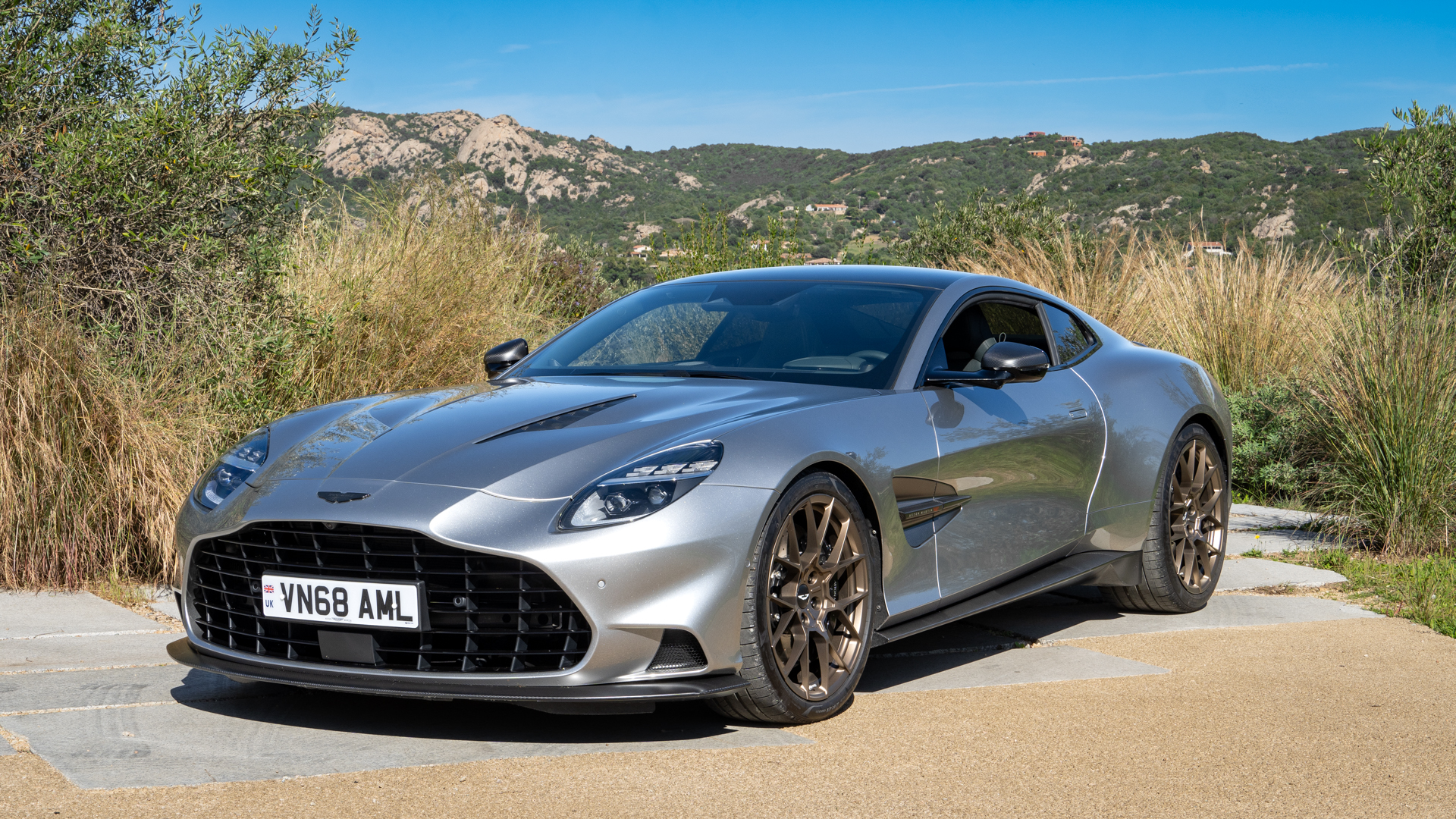

Does the Aston Martin Vanquish have the greatest car name of all time? The Jensen Interceptor might disagree, but it’s hard not to give Aston the crown, especially since the original Vanquish was driven by James Bond.
007's first-generation Vanquish fittingly went out of production in 2007, then it was half a decade before Aston revealed a successor. That car lasted for six years, then it was another six before the third-generation Vanquish you see here arrived. While Aston’s DB cars come along with a fairly regular cadence, and the last three generations of Vantage have followed each other in relatively quick succession, it would be fair to say a new Vanquish is a rare thing.
Replacing the DBS 770 Ultimate as the new Aston Martin flagship (discounting limited-run specials like the Valiant), the 2024 Vanquish is a big deal. With the DB12 and new Vantage each already taking Aston up a rung on the supercar ladder, the range-topping Vanquish has Ferrari’s most potent front-engined car, the new 12 Cilindri, firmly in its sights.
Can Aston finally take the fight to Ferrari? Read on to find out.
Price and availability
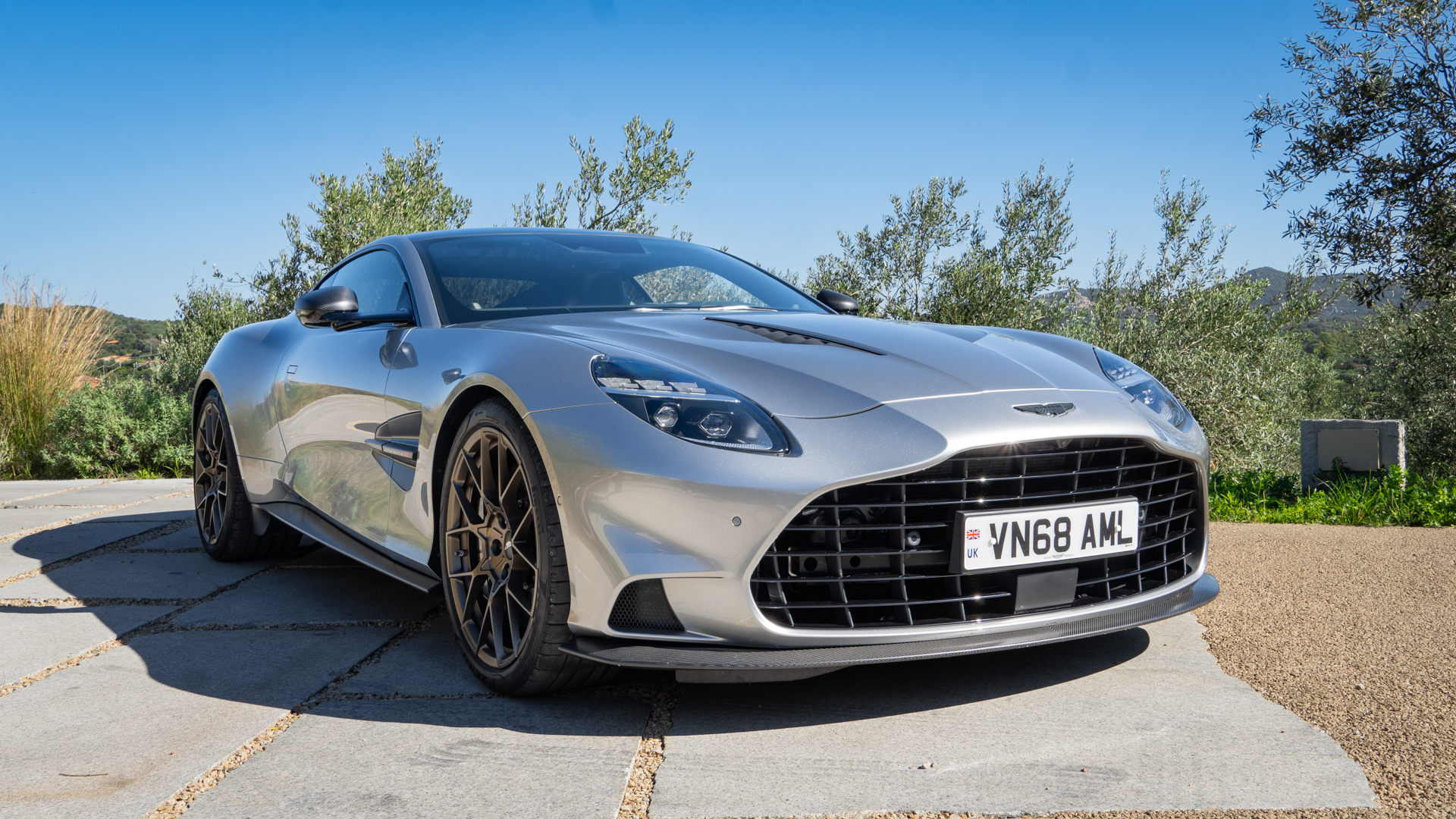
Aston Martin hasn’t yet confirmed the price for the Vanquish, but it’s expected to cost from £333,000. This makes it significantly more expensive than the DB12, to the tune of about £140,000, but puts it right in line with the Ferrari 12Cilindri. In a bid to make it somewhat exclusive, Aston says it will produce no more than 1,000 examples per year.
Design and interior

The first thing you need to know about the new Vanquish is that it’s long. Like, really long. Aston has stretched the wheelbase by 80 mm compared to the DB12, and all of that was added between the front axle and the base of the windscreen. This creates a nose that looks almost comically long in marketing images, but appears far more proportional in person.
The mouth also doesn’t look as enormous in the metal (or carbon, technically speaking…) but that’s probably due to the press car driven here being British and therefore having a front number plate to help break up the massive grille.
Sign up to the T3 newsletter for smarter living straight to your inbox
Get all the latest news, reviews, deals and buying guides on gorgeous tech, home and active products from the T3 experts
At the rear you’ll find a tail not dissimilar to Aston’s limited-run Valour and Valiant duo, complete with a beautiful set of LED lights framing an exposed carbon rear panel and a pronounced ducktail. Safe to say, you’re not going to mistake the new Vanquish for a DB12 any time soon – and the same could not be said of the previous Vanquish, nor the DBS that followed, or the DB11 that was closely related to both...
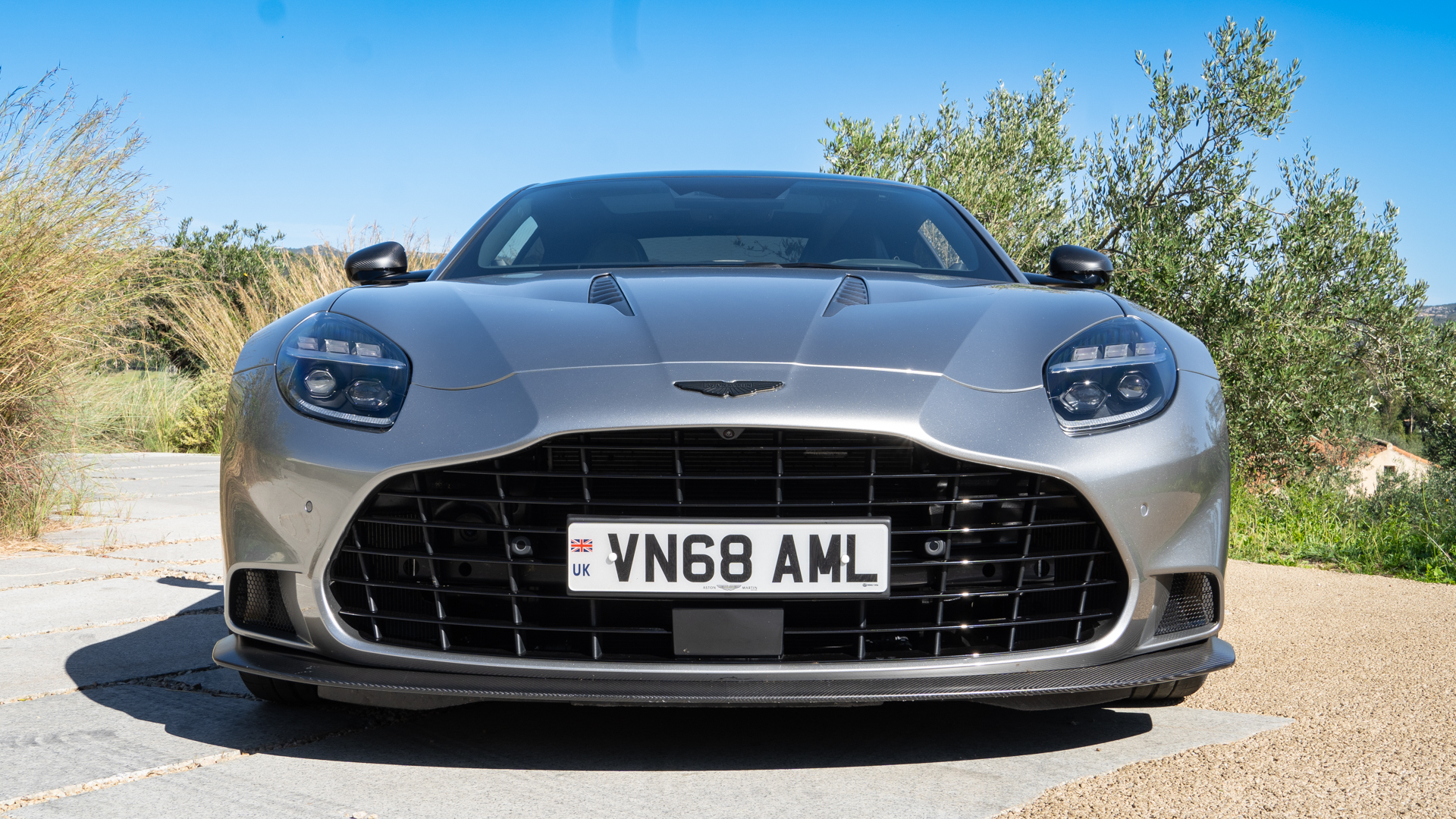
The massive external proportions don’t mean a roomier interior. Instead – and unlike the 2+2 DB12 with its child-friendly rear seats – the Vanquish is strictly a two-seater. The rear of the cabin is now home to a space for luggage. Naturally, Aston will sell you a set of tailored bags to make use of every square inch of space its designers deem your kids unworthy of.
The rest of the cabin is very similar to that of the DB12 and Vantage. Aston says the Vanquish has a lower seating position, so everything has moved, but in reality the controls are exactly where you expect them to be. This includes the touchscreen and infotainment that both take a quantum leap of improvement over the previous-generation system, and a centre console kitted out with physical buttons, toggle switches and rollers for things like cabin temperature, fan speed and the heated/cooled seats.
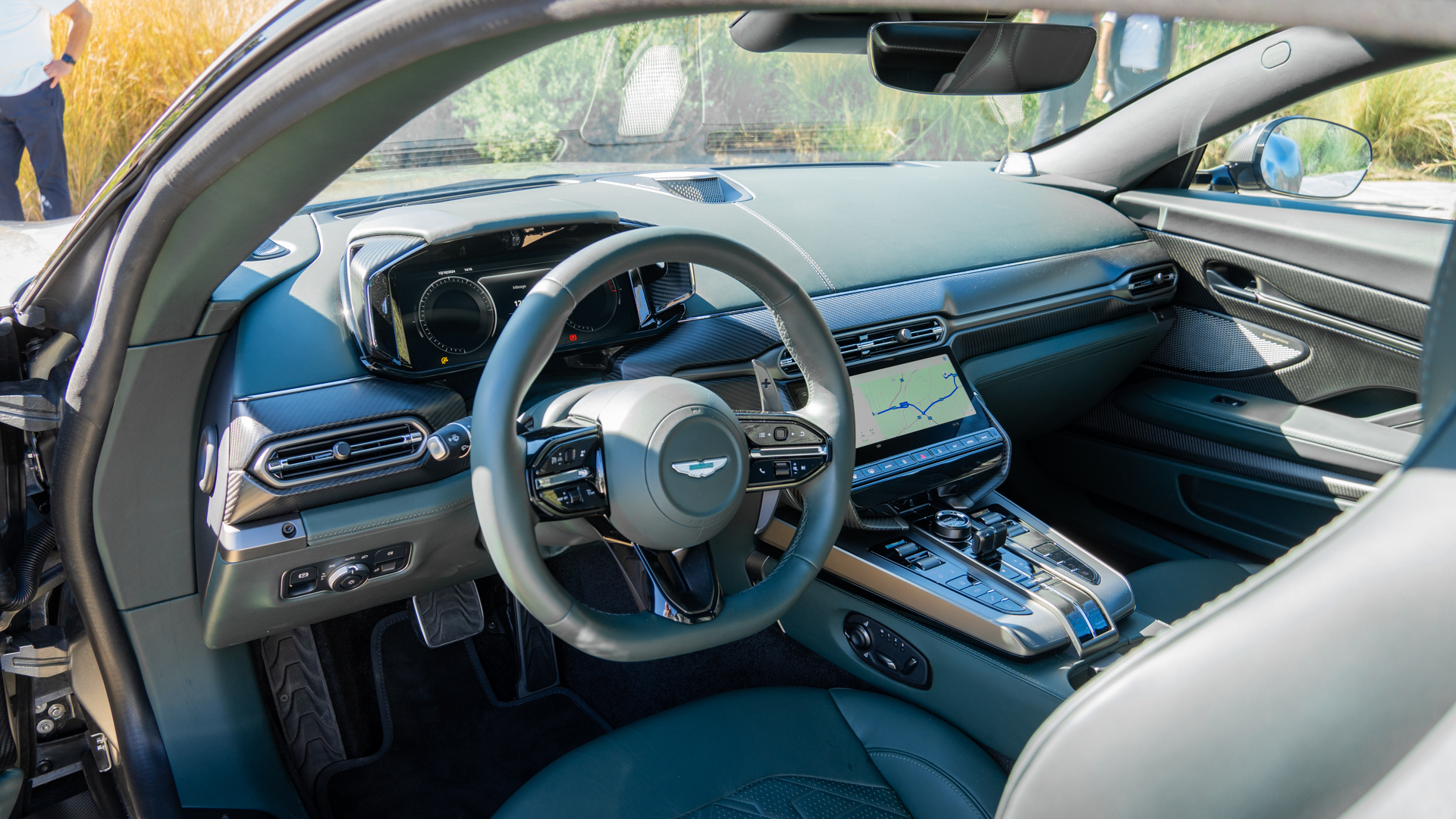
This is also where you find the start/stop button, which rotates to switch between drive modes, and rearwards of that is the selector for the eight-speed dual-clutch gearbox (there’s no manual option) and buttons for adjusting the exhaust, suspension and traction/stability control.
Just as with the Vantage, DB12 and DBX707, the cabin is beautiful. Every surface is wrapped in leather or made from carbon, while the seats are supportive yet comfortable and the tactility of the switchgear is spot on – except perhaps for the touchpads on the wheel, which take some getting used to, but can mostly be ignored.
Lastly, standard features include a large glass roof panel and a 15-speaker, double-amplified sound system from Bowers & Wilkins.

Performance and driving impressions
Just as when the new Vantage launched earlier in 2024, Aston Martin told journalists driving the Vanquish that it’s on a mission to head up-market. Instead of battling with the likes of Porsche, Maserati and Bentley, it now sees itself going head-to-head with Ferrari.
The quantitative argument is easiest to make, since the Vanquish conveniently produces 5 PS more than the 12Cilindri, at 835. That’s 824 horsepower in old money, and it’s joined by 1,000 Nm of torque (738 ft-lbs), which is a full 322 Nm more than the naturally-aspirated Ferrari.
All that umph comes from a new 5.2-litre, twin-turbocharged V12 engine. Instead of any kind of hybrid assistance, the Vanquish employs a new technology Aston Martin calls Boost Reserve. This increases the boost pressure of the turbochargers to beyond what is required when the throttle is partially applied, then holds that in reserve, ready to be deployed when the driver asks for full power. The result is practically zero turbo-lag.

Even without this clever new tech, such a massive V12 was never going to feel slow – and sure enough, the carbon-bodied Vanquish is incredibly rapid. It has a higher specific output (160 PS per litre) than any other Aston Martin V12 ever made, including that of the Valkyrie hypercar, and has a claimed 0-62 mph (100 km/h) time of 3.2 seconds. The top speed is 214 mph.
It feels every bit as quick as the numbers suggest, with especially potent in-gear acceleration that launches it down the road with real muscle.
Yet somehow the Vanquish makes over 820 hp feel manageable, at least on the warm, dry roads of our test route. I have no doubt this car can be a serious handful in the wet, but in optimal conditions it serves up plenty of grip and traction, while the elongated wheelbase brings stability. It doesn’t feel as on-edge as the shorter, less powerful Vantage, and serves up a heap of extra performance over the V8-engined DB12.
The Vanquish sounds fantastic too. Loud without being obnoxious, and with the ability to reach a higher pitch than I was expecting. To rev it right out to the limiter is to experience a heady dose of driving pleasure – and if you need extra volume, there’s also the three-stage exhaust button.
Or you can switch into Sport and Sport Plus modes. As in other Astons these ramp up throttle response, inject some anger into the eight-speed, dual-clutch gearbox, and firm up the suspension. Sport Plus is best saved for the track, unless you then dial back the suspension to its regular GT or Sport modes using the dedicated button. For me, Sport mode with the exhaust turned up is where the Vanquish works best.
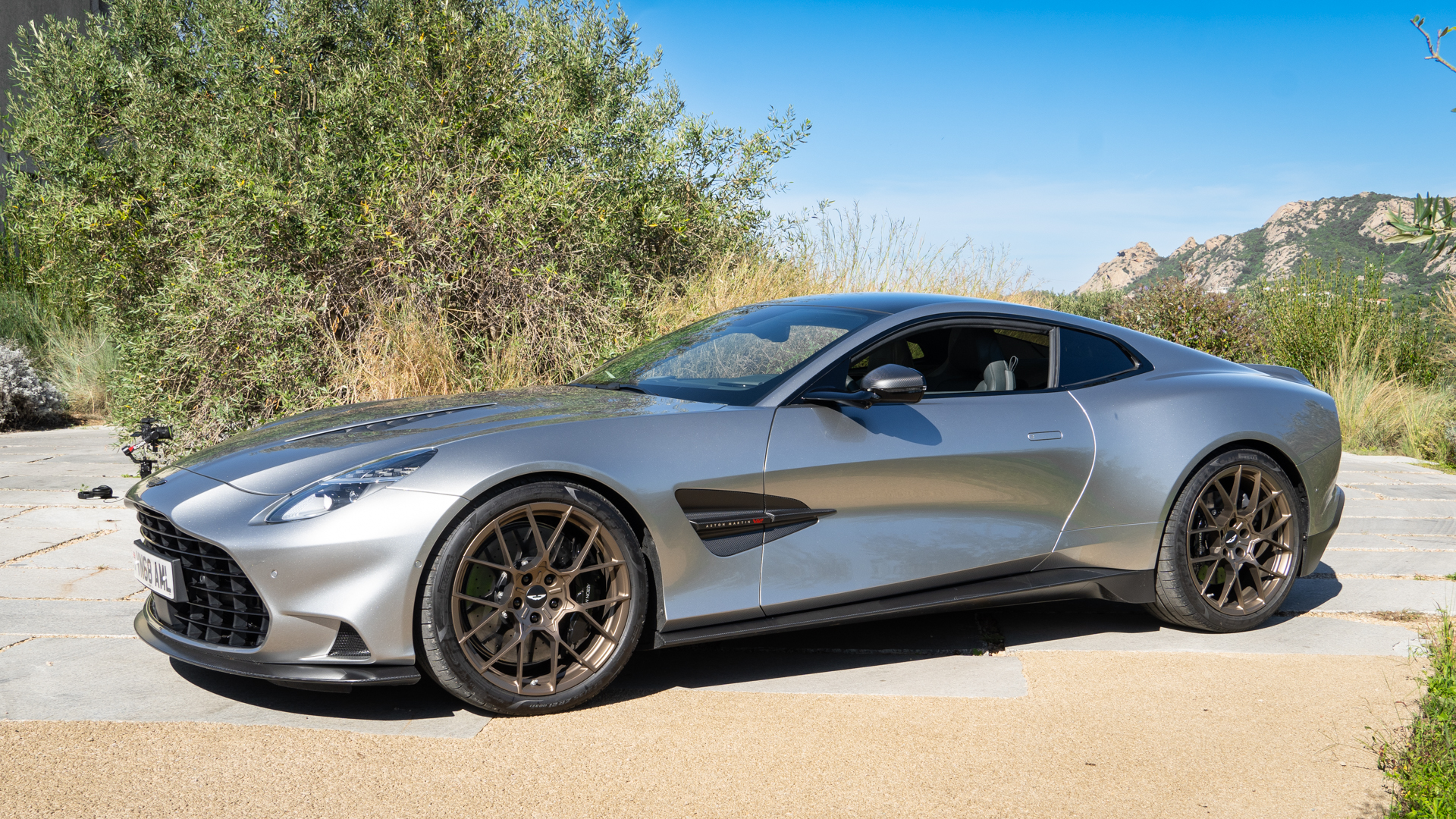
Even in comfortable GT mode and with the gearbox left in automatic, the car is eager to shift down a cog or two when you accelerate, reminding you this is a supercar as much as it is a grand tourer – and it sits closer to the former than the DB12 could ever dream of.
As well as good straight-line traction, the Vanquish holds on well through the corners too. This is clearly a car that will drift to your heart’s content with the multi-stage stability system turned down, but to regular drivers like myself it’s a car that feels planted, with steering that’s quick without feeling nervous, and a front end that refuses to be pushed off line. Take liberties though, and I have no doubt the Vanquish will give its driver a serious fright.
Carbon ceramic brakes are fitted as standard, with discs measuring a massive 410 mm at the front and 360 mm at the rear. Aston says they reduce unsprung mass by 17 kg compared to cast iron brakes, and they mean a reduction in brake fade when operating at up to 800 degrees centigrade.
The Vanquish rode well on our test route in Sardinia, but since this mostly consisted of smooth roads, I’ll reserve full judgement on ride quality until I’ve also driven it in the UK. For now though, the new Vanquish feels like a car that could potentially be used every day. It’s a little more civilised than the Vantage, but quicker and – thanks to that glorious V12 with its expensive soundtrack – even more special than the DB12.
Should I buy the Aston Martin Vanquish?
Aston Martin really is gunning for Ferrari with the new Vanquish. For some buyers that will likely be enough to reach for the credit card. I think it looks fantastic, sounds sensational and drives beautifully. It even beats the Ferrari 12Cilindri in a game of Top Trumps, as far as power and torque are concerned, while the Italian beats it to 62 mph.
Job done, mission accomplished? On paper, yes. But £330,000 supercars aren’t always bought on their specification sheets alone. Ferrari’s place at the top of the automotive tree has been hard-fought over multiple decades.
The Italian brand has a story to tell as much as it has cars to sell, and while Aston will always have Bond, it now has a car (a whole family of cars, really) with sector-topping performance and design to match. Then there’s the Formula One team, a return to the top flight of Le Mans next year, and another mid-engined supercar on the way, in the form of the Valhalla. Put all that together and yes – led by the Vanquish, Aston Martin is ready to take on the world.
Alistair is a freelance automotive and technology journalist. He has bylines on esteemed sites such as the BBC, Forbes, TechRadar, and of best of all, T3, where he covers topics ranging from classic cars and men's lifestyle, to smart home technology, phones, electric cars, autonomy, Swiss watches, and much more besides. He is an experienced journalist, writing news, features, interviews and product reviews. If that didn't make him busy enough, he is also the co-host of the AutoChat podcast.
-
 The new Mercedes Vision V concept might be the coolest van I’ve ever seen
The new Mercedes Vision V concept might be the coolest van I’ve ever seenThe interior of this Mercedes van looks more luxurious than a private jet
By Alistair Charlton
-
 One of Apple CarPlay's new Tesla-like features will soon be removed again
One of Apple CarPlay's new Tesla-like features will soon be removed againJust when you thought you could watch Netflix through CarPlay
By Rik Henderson